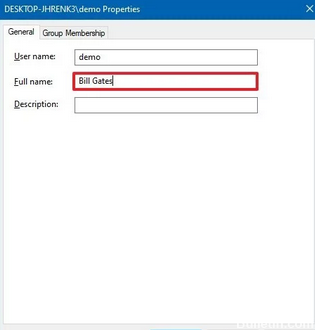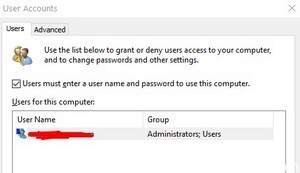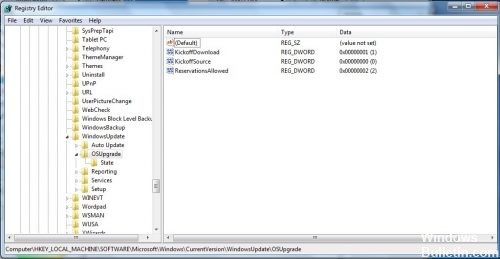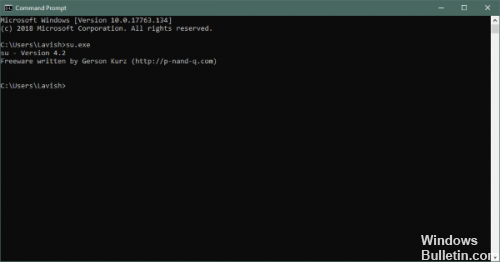Updated February 2025: Stop getting error messages and slow down your system with our optimization tool. Get it now at this link
- Download and install the repair tool here.
- Let it scan your computer.
- The tool will then repair your computer.
Under Windows, it is not possible to select a name for this folder. When you create a new user by entering the email address associated with a Microsoft account, Windows uses the first five letters of that email address as the folder name. In addition, it is not possible to rename a user profile folder after its creation.

If you prefer to use your full name for the profile folder, the trick is to start with a local account; if you do, Windows uses the full name of the account as the profile folder name. Once the user profile has been created, you can convert the local account to a Microsoft account.
Use the Control Panel to change the name of the local user account.

The easiest way to change the name of the local user account in Windows 10 is to use the Control Panel.
If you can’t find the “Change Account Name” link, try method 2.
To change your own username
1 In the search box, type User Accounts, then click User Accounts in the result to open the User Account setting in the Control Panel. (You can also open the Control Panel, then click on User Accounts.)
2. click on “Change your account name”.
3. enter the new account name, click on Edit Name. Then you will notice that your username has been changed.
Change the user account name with NETPLWIZ
February 2025 Update:
You can now prevent PC problems by using this tool, such as protecting you against file loss and malware. Additionally, it is a great way to optimize your computer for maximum performance. The program fixes common errors that might occur on Windows systems with ease - no need for hours of troubleshooting when you have the perfect solution at your fingertips:
- Step 1 : Download PC Repair & Optimizer Tool (Windows 10, 8, 7, XP, Vista – Microsoft Gold Certified).
- Step 2 : Click “Start Scan” to find Windows registry issues that could be causing PC problems.
- Step 3 : Click “Repair All” to fix all issues.
Before you begin, please backup all your data and create a system recovery point first.
Press the combination of Windows key + R, then type netplwiz in the Run dialog box. Click on OK. When prompted by the UAC, click Yes.
In the User Accounts window, enable the Users must enter a user name and password to access this computer if it is not enabled. In the User Name section, select the user name for which you want to change the name and click Properties.
In the Properties window, in the User Name field, enter the desired user name. Then click on Apply, then on OK.
Use of the Registry Editor

This can be done without renaming folders and without interfering in the registration process:
- Create a local account with the desired user name.
- Creating a local account is well hidden; here’s how to find it:
- Settings > Accounts > Family and other users > Other users > Add other users to this computer > The person I want to add has no email address > Add a user without a Microsoft account
- Change the account type to Administrator (can skip if there is another administrator).
- Delete the original Microsoft linked account
- Link the local account to the Microsoft account if you wish.
Using the Command Prompt

You can also use the command prompt to add a first name and last name to a local account by following these steps:
Open Start.
Locate the command prompt, right-click on the top result and select Run as administrator.
Type the following command to add the full username and surname to the local account and press Enter :
net user demo / full name: “YOUR FULLNAME”.
After completing the logout steps and during the login process, the full name you specified should now appear on the login screen.
CONCLUSION
Configuring the default profile is an easy way to make general adjustments, improve connection times and make the overall user experience much easier. It also reduces the number of basic policies required for the user environment, as they can be integrated. Ideally, this process should be repeated for each new version of Windows 10.
You can also, if you wish, centralize the deployment of your default profile by copying the profile you create into a NETLOGON sharing folder and calling this folder Default User.v6 (Windows 10 1703 or later versions of Windows 10 use the suffix.v5). In this case, you can make changes in one place and reflect them everywhere (provided that a DC connection is available for the customer).
https://superuser.com/questions/890812/how-to-rename-the-user-folder-in-windows-10
Expert Tip: This repair tool scans the repositories and replaces corrupt or missing files if none of these methods have worked. It works well in most cases where the problem is due to system corruption. This tool will also optimize your system to maximize performance. It can be downloaded by Clicking Here
